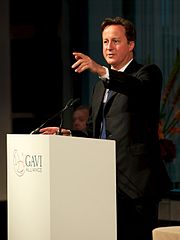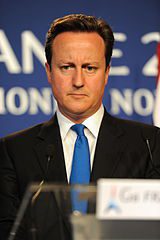Wherever you stand on the issue of Britain’s EU membership, no doubt you will be hearing about David Cameron’s speech made this morning on the topic. Reading between the lines, and ignoring the political bluster, the format of the speech and the language used have some interesting lessons for bloggers and copywriters. Here are three tips which can be lifted from the speech and put to use for great copywriting success.

“EU. Yes EU back there. Pay attention if you want some great blogging tips”
1. Visual language engages
Several times Cameron employed the use of descriptive language to help engage listeners with his “vision”.
“A war which saw the streets of European cities strewn with rubble. The skies of London lit by flames night after night. And millions dead across the world in the battle for peace and liberty.”
“I never want us to pull up the drawbridge and retreat from the world. I am not a British isolationist.”
“Let’s stop all this talk of two-speed Europe, of fast lanes and slow lanes, of countries missing trains and buses, and consign the whole weary caravan of metaphors to a permanent siding.”
The choice of words used clearly encourage the listener to visualise what is being said, helping to keep them focused on the message. This use of powerful descriptions is an extension of the old copywriting technique “Show don’t tell” which has helped businesses sell since the beginning of the advertising age.
2. Ask and answer questions
The speech is littered with examples where David Cameron asks a question before going on to provide his own answer. Good copywriting often presents readers with questions and problems before going on to supply the answer.
However there is a trick to using questions well in copy, just as there are in Cameron’s speech. Questions should never be open-ended (otherwise your reader could supply themselves with the “wrong” answer), even if that means the answer is blindingly obvious. Look at Cameron’s example:
“Can we justify a Commission that gets ever larger? Can we carry on with an organisation that has a multi-billion pound budget but not enough focus on controlling spending and shutting down programmes that haven’t worked?”
The correct (and only logical) answer to these questions is of course “no”. The listener immediately engages with the speech, helping to ensure they continue to listen to the end. So too with using questions in web content – use closed questions to which your reader already know the answer to keep them hooked.
3. Use points for emphasis
David Cameron used his speech to outline his vision for a new European Union, using five principles to explain it. A technique popular with copywriters and bloggers is to write web content that uses points to split up text, to guide the reader down the page and to firmly emphasis the key aspects of their marketing message.

Cameron hopes ‘EU’ understand these copywriting tips
As with Cameron’s speech, it is crucial to:
- Tell readers in advance how many points you will be making (“It is built on five principles“)
- Make it clear when you are starting a new point (“The second principle should be flexibility“)
- Let the reader know when you have finished your list (“These five principles provide what, I believe, is the right approach for the European Union“)
Which helps explain why you see so many blog posts with titles like “5 ways to use a widget”, “8 tips for greater success” and “3 tips from Cameron’s EU speech for bloggers & copywriters” (see what I did there?).
So there you have it. 3 tips lifted directly from Cameron’s speech which can help your copywriting succeed. Don’t say the Government never gives you anything.
Need help? Tech Write offer technical copywriting services to digital media agencies and customers direct to help create web content that works. Drop us a line and see how we can help (I promise not to talk politics either!).










































Full of salient points. Don’t stop beiveling or writing!